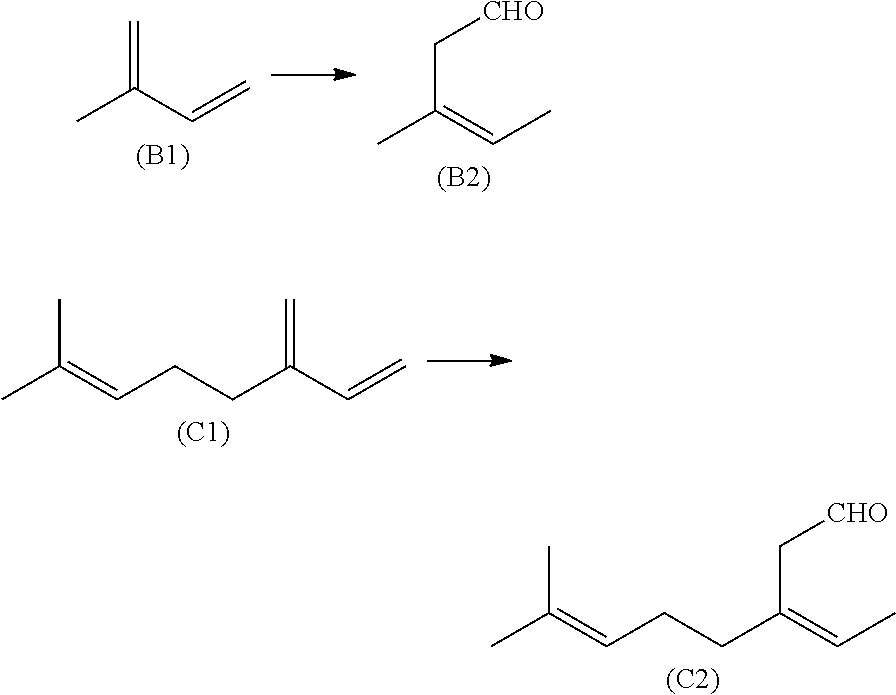Method for the hydroformylation of 2-substituted butadienes and the production of secondary products thereof, especially ambrox
a technology of substituted butadienes and hydroformylation method, which is applied in the direction of hydrocarbon preparation catalysts, organic compounds/hydrides/coordination complexes, physical/chemical process catalysts, etc., can solve the problems of not having the same performance as the preparation of 8-methyl-4-methylene, corrosion problems, and inability to meet the requirements of industrial us
- Summary
- Abstract
- Description
- Claims
- Application Information
AI Technical Summary
Benefits of technology
Problems solved by technology
Method used
Image
Examples
example 1
[0298]5.1 mg of rhodium biscarbonylacetylacetonate and 92.3 mg of tBuSkatOX (ligand-metal ratio=5:1) were dissolved in 10 g of THF and placed into a 100 ml autoclave flushed with CO / H2 (1:1) using a syringe. Then, at 10 bar CO / H2 (1:1) and 70° C., preformation was carried out for 30 min. The system was then decompressed and 10 g of trans-ß-farnesene were added using a syringe. The hydroformylation was carried out at 70° C. and 40 bar CO / H2 (1:1). Analysis of the reaction discharge after a reaction time of 48 hours revealed a conversion of 92.5% with a selectivity to the target product (7E)-8,12-dimethyl-4-methylenetrideca-7,11-dienal of 70.4% and a yield of target product of 65.1%.
example 2
[0299]5.1 mg of rhodium biscarbonylacetylacetonate and 92.3 mg of tBuSkatOX (ligand-metal ratio=5:1) were dissolved in 10 g of THF and placed into a 100 ml autoclave flushed with CO / H2 (1:1) using a syringe. Then, at 10 bar CO / H2 (1:1) and 70° C., preformation was carried out for 30 min. The system was then decompressed and 10 g of trans-ß-farnesene were added using a syringe. The hydroformylation was carried out at 70° C. and 40 bar CO / H2 (1:1). Analysis of the reaction discharge after a reaction time of 70 hours revealed a conversion of 99.3% with a selectivity to the target product (7E)-8,12-dimethyl-4-methylenetrideca-7,11-dienal of 68.6% and a yield of target product of 68.1%.
example 3
[0300]5.1 mg of rhodium biscarbonylacetylacetonate and 44.4 mg of tMe-Rucaphosphite (ligand-metal ratio=3:1) were dissolved in 10 g of THF and placed into a 100 ml autoclave flushed with CO / H2 (1:1) using a syringe. Then, at 10 bar CO / H2 (1:1) and 70° C., preformation was carried out for 30 min. Then, the system was decompressed and 10 g of trans-ß-farnesene were added using a syringe. The hydroformylation was carried out at 90° C. and 40 bar CO / H2 (1:1). Analysis of the reaction discharge after a reaction time of 48 hours revealed a conversion of 87.3% with a selectivity to the target product (7E)-8,12-dimethyl-4-methylenetrideca-7,11-dienal of 71.9% and a yield of target product of 62.7%.
PUM
| Property | Measurement | Unit |
|---|---|---|
| bite angle | aaaaa | aaaaa |
| temperature | aaaaa | aaaaa |
| temperature | aaaaa | aaaaa |
Abstract
Description
Claims
Application Information
 Login to View More
Login to View More - R&D
- Intellectual Property
- Life Sciences
- Materials
- Tech Scout
- Unparalleled Data Quality
- Higher Quality Content
- 60% Fewer Hallucinations
Browse by: Latest US Patents, China's latest patents, Technical Efficacy Thesaurus, Application Domain, Technology Topic, Popular Technical Reports.
© 2025 PatSnap. All rights reserved.Legal|Privacy policy|Modern Slavery Act Transparency Statement|Sitemap|About US| Contact US: help@patsnap.com



